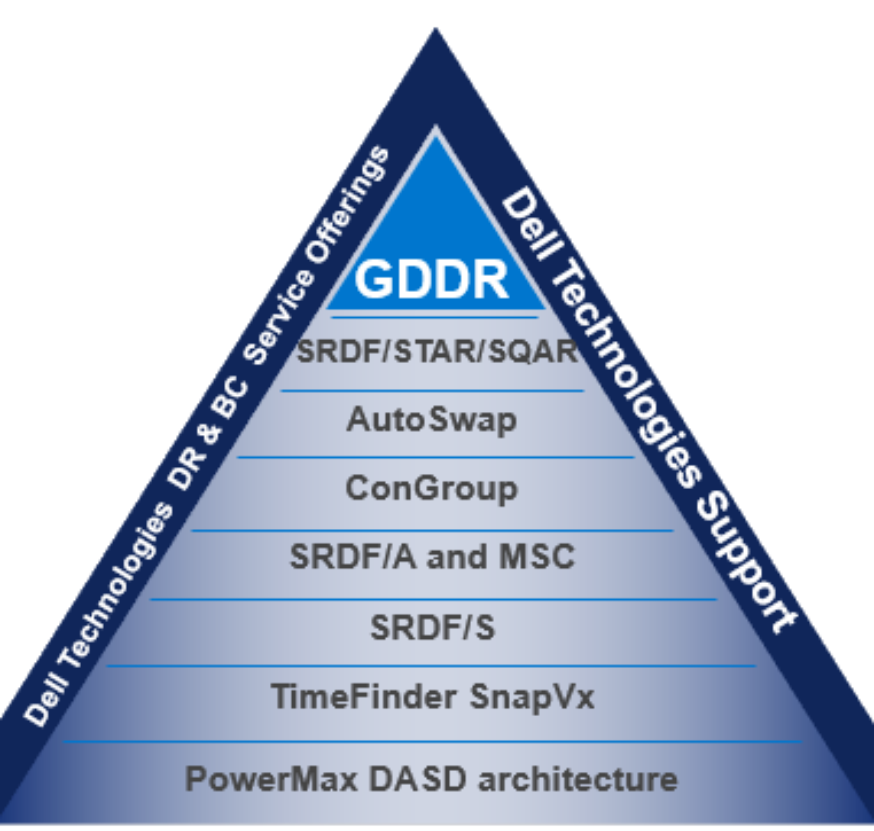Home > Storage > PowerMax and VMAX > Data Protection > Dell Technologies Geographically Dispersed Disaster Restart (GDDR) for PowerMax > Overview
Overview
-
Dell GDDR is a mainframe software product that automates planned storage switchovers between datacenters as well as unplanned storage recovery by reacting to events that its monitoring detects in the data center, including cyber security events. These three functions (automate, react, and monitor (ARM)) combine to enable continuous operations across planned and unplanned outages. GDDR is designed to perform planned data center site switch operations and to restart operations following disasters, ranging from the loss of compute capacity and/or disk and tape access, through to total loss of a single data center or a regional disaster, including the loss of dual data centers. In other words, GDDR provides continuous availability, disaster recovery and cyber resiliency. GDDR achieves this goal by providing automation to complement the functionality of the Dell hardware and software products required for business restart.

Because GDDR provides system restart following disasters, its control functions do not reside in the same systems that it protects. GDDR’s control system resides on separate logical partitions (LPARs) from those that run application workloads (called ‘managed systems’). GDDR monitors and can direct actions on managed systems via a started task on those systems. For example, in a three data center SRDF/STAR configuration, a GDDR control system is installed on a control LPAR at each site. Each GDDR control system is aware of the other GDDR control systems through network connections between each site, with one control system designated as the primary control system. This awareness enables the monitoring that is required to react to disasters, identify survivors, nominate the leader, and then automate the necessary actions to resume operations and restart managed systems at one of the customer-chosen surviving sites.
To achieve business restart, GDDR automation extends into the host operating system layer. It is at this layer that sufficient controls and access to third party software and hardware products exist to provide automated recovery services.
Cyber Resiliency has emerged as a critical component of business continuity planning, and GDDR has expanded to provide further integration with Dell’s Data Protector for z Systems (zDP) cyber resiliency solution. GDDR integrates with zDP to provide a single point of operational control for managing a zDP environment, including testing system recovery from zDP-created point in time snapshots of the entire z/OS environment, and automating recovery operations for zDP itself as part of overall business continuity resiliency.
GDDR also provides automation for creating a physical cyber vault copy of data using its Cyber Protection Automation for mainframe (zCPA) feature, supported on all GDDR topologies. zCPA is designed to automate the periodic creation of space efficient snapshots in a separate cyber vault array, which can be optionally air-gapped from the production and disaster recovery arrays managed by GDDR.
In comparison to other mainframe storage switching and failover automation products, Dell GDDR is unique in that it is a single product, using artificial intelligence (AI) to dynamically create an automation script to handle a planned or unplanned event. The AI simplifies GDDR’s design, implementation, and maintenance because only ONE product needs to be purchased, maintained, and reconfigured as storage configurations and datacenters change over time. It is designed and tested to handle the complexity and variability of 16 different customer configurations of sites and software products. Contrast this with competitors who rely on creating many custom “versions” of their base software to deal with configuration differences, making it nearly impossible to move from one configuration type to another without completely re-engineering the solution. For GDDR, it is simply a matter of using parameters to redescribe the configuration and rerunning discovery utility software.
